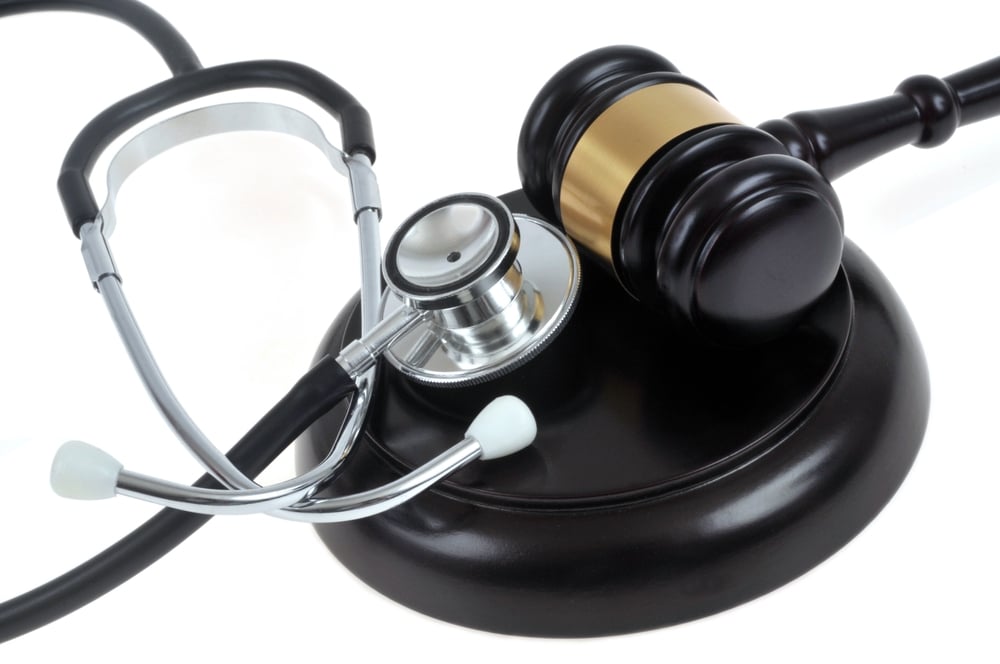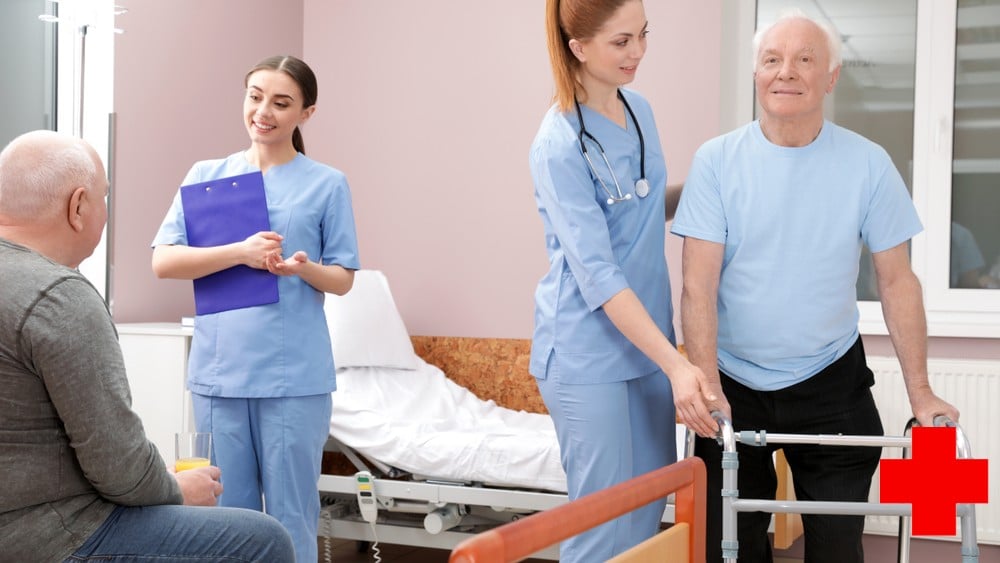Other Free CNA Study Guides:
There are 3 Modules in CNA Study Guide. Here you can navigate all the CNA Study guide modules.
- CNA Module 1 | Nursing Physical Care Skills
- CNA Module 2 | Psychosocial care skills
- CNA Module 3 | The Nurse aides role
Let’s get started right away.
In the nurse aides role, we look at various aspects in this section, but we start off with communication. Check out our free CNA study guide module 3.
Communication

Communicating with patients
Communication is key when interacting with patients on a daily basis.
For communication to take place, there are five elements needed:
- Sender: The source of the message
- Message: What is being communicated by the sender
- Channel: How that message is conveyed, usually in a verbal or nonverbal manner
- Receiver: They receive the message
- Feedback: This is how the receiver responds to the message that they get
The most common form of communication is verbal and this is how a nurse aide will deal with patients daily.
In doing so, the way a patient is speaking, their choice of words, as well as the tone of their voice, should always be noted.
Communication can be nonverbal as well.
This sees messages sent but not through speaking.
In terms of communication between a nurse aide and their patients, it has a role to play as it can express both attitudes and emotions.
Examples of nonverbal communication include the use of touch, gestures, and even body language.
The body language of a nurse aide in dealing is key too.
For example, if a patient is explaining something and the nurse aide continually is looking at their watch, the patient will get the idea that they aren’t really interested in hearing what they have to say.
While speaking of communication, we must mention therapeutic communication as well.
During this type of communication, a nurse aide encourages patients to share information and be open with them.
To do so, a combination of verbal and nonverbal communication is used.
Always take note of body language because it’s an effective tool for interpreting the overall emotional state of a patient which can aid in effective communication.
As a nurse aide, you should always look to encourage communication from patients.
This starts with the patient understanding that they are free to communicate whenever they so wish.
Patients that feel comfortable in their environment will communicate more than those who don’t feel comfortable.
If a patient is to take part in the therapeutic conversation, they need to have their privacy respected as well.
That’s because as part of the communication process, they may have to share personal information they could feel embarrassed about.
A nurse aide should give the patient as much time as possible as they communicate, remain involved, and maintain eye contact.
Don’t be afraid to ask questions either.
This is an effective tool in encouraging the patient to communicate even more.
Questions can be closed-ended, for example, ‘Did you eat your lunch today’ as well as open-ended.
By asking open-ended questions, you encourage the patient to provide more detail about the topic at hand.
An example of an open-ended question is one in which a patient cannot simply give a one word answer.
As part of communicating with a patient, a nurse aide should make use of active listening.
Simply put this means devoting all your attention to the patient as they speak and making sure you formulate the best response to encourage the patient to communicate even more.
When using active listening, the nurse aide will also take note of nonverbal communication, such as the body language of the patient.
Communication should also involve empathy as this helps a patient to understand that the nurse aide truly cares about what they are going through.
The power of touch shouldn’t be underestimated either, for example, holding the hand of the patient.
Note, however, not all cultures may see this as a sign of disrespect, so bear that in mind as well.
Communicating with a patient’s family
During the course of a patient’s stay in a medical facility, nurse aides will come into contact with their family members, so proper communication with them is key as well.
Should these conversations take place with the patient present, they should always be included.
Any questions that family may have about patient care, however, aren’t for a nurse aide to answer, so they should be referred to the nurse.
Lastly, communication with the family should not use complicated medical terms that they won’t understand, so keep it as simple as possible.
Patient call lights
Call light answering
When a patient is in need of assistance and no staff are nearby, they can make use of the call light to call them.
When a patient makes use of their call light, the response by the staff should be as quick as possible, even if it’s from a room that’s not assigned to the nurse aide.
Patient’s rights

In this section, we look at the rights of a patient when they spend time in a medical or care facility.
Patient’s bill of rights
The rights of all patients are enshrined in the Patient’s Bill of Rights.
These rights are listed and a patient can expect to receive them while under medical care.
The patient too, however, also has certain responsibilities to ensure effective treatment.
Patients’ specific rights
Let’s look at some of the specific rights that a patient is assured of.
- They have a right to confidentiality
- They have a right to privacy
- They have a right to informed consent
- They have a right to freedom of choice
- They have a right to respectful care
- They have a right to continuity of care
- They have a right to telephone and mail access
- They have a right to look at their chart
- They have rights related to experimental treatments in that they can turn them down if they wish
- They have rights of refusal when it comes to procedures and treatments
- They have a right to leave the facility (if oriented and alert)
- They have a right to have their valuables kept safe
- They have the right to healthcare worker identification
Medical durable power of attorney
If a patient is unable to make medical decisions for themselves, someone that’s been given medical durable power of attorney can do so on their behalf.
For the most part, this will be filed by a lawyer before a patient is hospitalized and would take effect when the patient becomes comatose, for example.
It’s important that the person making the decisions on a patient’s behalf should do so based on the wishes of the patient.
End of life care: Advanced directives
When a patient is in end of life care, advanced directives can be used to detail their wishes.
This could include their wishes on receiving nourishment via a feeding tube, or long-term mechanical ventilation, for example.
It could also include their wish to be an organ donor following their death.
Patients who want to draw up advanced directives will usually do so together with a lawyer before they go to the hospital.
They should be brought to the attention of hospital staff upon admission and if given to the nurse aide, they should notify the nurse about these directives immediately.
Do not resuscitate (DNR) orders
Patients may request a DNR order which means that when they die, no attempt should be made to resuscitate them.
Usually, this is something they would have decided on after consultation with their doctor.
Sometimes a patient may opt for some types of emergency treatments, but typically not the full scope that is available in an attempt to resuscitate them.
DNR orders can be reversed, even verbally.
So if a patient asks a nurse aide verbally that the order should be reversed, the charge nurse should be notified.
The responsibilities of the patient
Medical care facilities have responsibilities toward patients, but they, in return, have responsibilities of their own.
To start, a patient has responsibilities related to their care.
In an effort to ensure they have an optimal level of health, they have a significant and active part to play.
In fact, on entering the medical facility for their stay, they should be provided with a list of the responsibilities expected of them.
This includes treating the health care providers with respect, complying with their individual treatment plans, meeting the financial obligations related to their hospital stay, and more.
Adequate treatment may not be provided if a patient fails to meet these responsibilities.
Patients should also attempt to maintain a healthy lifestyle after their hospitalization.
This could include changes to their diet, starting an exercise routine, and making the right lifestyle choices.
As patients can expect to be treated with respect and honesty by nurse aides and other medical staff, they too should act in a respectful manner towards health care workers.
They should act in a manner that allows the health care workers to provide them with the care they deserve.
Any inappropriate behavior in this regard should be reported by the nurse aide to their superiors should it occur.
Patients should also be honest in their interactions with staff, specifically when it comes to answering questions regarding their condition as well as their social and medical history.
This ensures they get the proper treatment.
Legal factors and behavior

When a patient is in hospital, there are various legal issues to consider
HIPAA
Who can receive healthcare information about a patient is governed by the Health Insurance Portability and Accountability Act (HIPAA).
This also governs how the information is acquired, the ways it can be shared, and the patient’s overall rights with regard to it.
Ultimately, it’s the privacy of the individual that the HIPAA seeks to protect.
OSHA
Healthcare workers have a right to be kept safe and healthy while carrying out their jobs and that’s what the Occupational Safety and Health Act (OSHA) seeks to ensure.
This ensures that a safe environment is provided by their employers which includes notifying of potential hazards and providing the correct gear.
Injury and illness is therefore kept to the barest minimum when employees follow the stipulations of the OSHA.
OBRA 1987
The Omnibus Budget Reconciliation Act of 1987 (OBRA 1987), also known as the Nursing Home Reform Act pertains directly to nursing homes and looks to protect the rights of patients living in them.
This ensures that there is a comprehensive care plan for each patient and that following their initial evaluation, further ones are carried out each year.
OBRA 1990 (PSDA)
The Patient Self Determination Ast (PSDA) is itself an amendment included in the Omnibus Budget Reconciliation Act (PSDA 1990).
All patients must be informed about advanced healthcare directives and their right to accept or reject them.
When patients make an advance directive, these act as instructions regarding medical interventions they will allow to be used on them if they become incapacitated.
If they choose, a patient can nominate someone else, for example, a family member, to make these decisions on their behalf.
Under the PSDA, patients have the right to refuse medical treatments as well.
Nurse practice act
Regulation of nursing in each state within the US is carried out in the nurse practice act of that state.
This specifically relates to the education needed to become an RN as well as what their role is and responsibilities are.
Standards of care
A nurse aide’s behavior in various situations is outlined in this guideline.
Usually, this will be drawn up by the facility they are currently working in and the responsibility falls on the nurse aide to know what they are.
Should a nurse aide not adhere to these standards and deviate from the practice laid out in the standard of care, they can be liable if a patient comes to any harm.
Liability
People are responsible for acting within the boundaries of the law when it comes to their overall liability.
In other words, taking responsibility for the action that they carry out.
How does this impact a nurse aide?
Well, first of all, they should be doing everything to the best of their abilities.
They can also be liable should they carry out a task that doesn’t fall under their duties, especially if a patient is harmed in any way because of it.
Assault
We are not specifically talking about hitting a patient here or something similar, although that would fall under this term as well.
Assault can also include forcing a specific treatment on a patient who had declined it.
In this situation, the patient is not harmed in any way, but the behavior of the medical personnel will be considered assault.
Negligence
Nurse aides receive specific training in order to carry out their jobs correctly.
When they don’t do this, it can be considered as negligence.
An example of this would be leaving a patient in the shower unattended who then injures themselves in a fall.
Taking shortcuts to perform tasks that can result in injury to a patient is also considered as negligence.
Battery
When touching a person without permission, they could see this as battery.
Normally, battery is seen as a violent act but in the medical field, this act could be unintentional.
That’s why it’s critical that when performing a procedure on a patient, a nurse aide must get consent from them.
Never go ahead if the patient doesn’t consent to the procedure, but instead, explain to them why it is necessary and see if they will change their minds.
Invasion of privacy
Throughout this guide, we’ve stressed how important the privacy of a patient is.
A nurse aide cannot pass on personal information about any patient to another colleague without the consent of that patient.
Leaving sensitive documents pertaining to a patient where others can see them could also be construed as an invasion of their privacy.
Should anyone require information about a patient who isn’t directly involved in their treatment, they should be referred to the change nurse at all times.
Malpractice
In malpractice, a professional fails to follow the standards of care expected of them.
This won’t apply to a nurse aide, however, but it is still worth understanding the difference between malpractice and negligence.
While we won’t cover them in much detail now, you should also know of the following when it comes to legal factors for the exam:
- Defamation (both slander and libel)
- Fraud
- Abandonment
- Theft
- Resolution of grievances and disputes (including mediation and arbitration)
Ethical behavior

In this section, we cover a range of subjects under the banner of ethical behavior.
Ethical principles
Let’s start by looking at various ethical principles the nurse aide should be aware of.
Autonomy
When it comes to their care, a patient has the right to make their own decisions and therefore have autonomy.
Some patients cannot be considered autonomous and these include children and those with dementia, for example.
In this case, someone will act as a legal decision maker on their behalf and so, they should have all the relevant, up-to-date information possible to make these decisions.
Justice
Society should be able to benefit from limited resources of healthcare benefits in accordance with this ethical principle, meaning they should be allocated in a fair manner.
Think of it in this way.
Consider a medical facility that only has one open bed but two patients need it.
Which patient gets the bed and which is transported to another facility?
Well, there should be no personal bias when deciding and whoever gets the bed is the patient that, at that point in time, needs medical assistance the most.
Beneficence
According to this ethical principle, actions are performed in order to benefit others.
In other words, when a patient is treated, the ultimate goal is to choose procedures or treatments that provide the most benefit to them.
All other options need to be reconsidered.
That said, the condition of a patient is ever-changing and this means that measures to treat them should always be reassessed to see if they still benefit them.
Nonmaleficence
This is the final ethical principle you should know and it means that when providing care to a patient, a healthcare worker must do it in a manner that does not bring harm to them.
Bioethics
This holds that the treatment given to a patient on a medical level is the most morally correct based on the various options available.
A bioethical dilemma can come about if there is a difference in the value beliefs between a patient, their family members, and the hospital staff.
This should be resolved through explanation and discussions between the relevant parties.
If it cannot be, the ethics committee of the medical facility will need to help resolve the conflict.
Bioethics has the primary goal of ensuring that based on the current circumstances, the most morally correct action is taken.
Code of ethics for nursing staff
Because of the advances made in prolonging the life of patients, prenatal manipulation, saving of premature infants, and organ transplants, for example, ethics have been thrust to the forefront of healthcare.
The problem lies in the fact that resources can be limited in healthcare, and that can lead to many ethical dilemmas.
The American Nurses Association Code of Ethics includes a number of statements nurses should consider in moral or ethical situations.
All nurses should be aware of these statements and make use of some form of ethical decision making model to help guide them when facing difficult situations.
These vary but some general guidelines for using them include:
- The problem is identified and all the necessary information about it is gathered
- Look for alternatives or solutions to the problem that are reasonable
- Ethical resources can be utilized to provide guidance, for example, an ethics committee.
- Propose possible solutions and try them
- Settle on a final solution to the problem
When trying to assist with ethical decision making the following should always be considered: autonomy, beneficence, nonmaleficence, justice, and fidelity.
Professional boundaries
When patients are in hospital for long periods of time, there is no doubt that a bond can form between them and the medical staff that work closely with them.
Often, as a token of their appreciation, they may offer gifts.
There’s nothing wrong with that if it’s a small gift like a box of chocolates, for example, but no medical personnel should accept money or valuables from their patients.
If this happens, they should be declined while informing the patient that it is against the policy of the medical facility to accept them.
It also goes without saying that crossing boundaries that result in any form of sexual relations are not allowed.
Finally, for nurses involved in home care, paying patients extra attention can be detrimental.
You should carry out duties within the scope of your job description.
Doing extra favors such as cooking or going to buy groceries isn’t necessarily a good thing, even though you may be helping out.
That’s because it could result in the patient becoming far too reliant on you.
Paying too much attention to a patient in a hospital setting could be seen as favoritism.
We need to touch on coercion here as well.
Even if you have an excellent relationship with a patient, if they aren’t wanting to have a particular medical procedure carried out, that’s their decision.
They cannot be coerced or intimidated into it.
In closing out this section, let’s touch on disclosing personal information.
While there is nothing wrong with being friendly with patients, a nurse aide should never provide them with any personal information.
The main reason for this is that it blurs the boundaries between the professional role they must play and essentially brings about a social relationship.
There’s an air of vulnerability to the patient should too much personal information be disclosed to them as well.
The health care team

We begin by looking at the various roles played out in a medical facility.
Health care team members
These include the following:
- The patient is included in this because they are the most critical component
- Then we have the physician who decided on what treatment and medication the patient needs
- The nurse administers these medications but will continually assess the patient as well
- The nurse aide plays a role in patient care as well and carries out day-to-day tasks
- On occasions, specialists might be called for various aspects of treatment. A physical therapist is a good example of these
Certified nurse aide
Obviously, we are going to focus more on the certified nurse aide because that’s what the exam covers.
While certification requirements vary from state to state, most require that a nurse aide has 75 hours of training behind them at a minimum.
Following that, they take the state certification exam which includes a written section as well as the nurse aide demonstrating their skills.
Every two years, the nurse aide will have to renew their certification and for that to happen, they have to have either worked for the specified number of minimum hours.
Should they not have the correct minimum hours, the exam will need to be taken again.
As for continuing education requirements, every year a nurse aide will have to report at least 12 hours in this regard.
Nurse aide responsibilities
It’s the basic needs of a patient that the nurse aide is primarily responsible for.
We won’t go into any great detail here because the coursework and your practical knowledge will cover all of this.
What we will talk about, however, is prioritization of these responsibilities.
A care plan should be based on priority and in turn, that should be based on:
- Those duties that are from the delegating nurse must always be carried out first
- Those duties that a medical response might be needed which include taking vital signs, for example
- Those duties that focus on the overall well-being of the patient as well as their health, for example, toileting, ensuring they take in the right amount of liquids and food, and more
- Those duties that focus on routine care, for example, changing bed linen. While these are the lowest ranked in terms of priority, they shouldn’t be overlooked
The nurse aide has a role to play in the planning and implementation of care plans too.
As a nurse aide spends more time with the patient than doctors or a head nurse, for example, they can provide valuable insight to the care team.
This can include the patient’s overall progress, what their emotional status is like, what concerns the nurse aide might have, and much more.
As part of the care plan, the nurse aide plays a critical role.
For example, they will ambulate patients, observe their intake and output, help prevent infections, and more.
Assignment refusal
Nurse aides can refuse assignments given to them, particularly if they do not fall within their scope of practice.
They can also refuse an assignment they feel could bring harm to a patient or themselves but only should opt for this course of action if they have a good reason to.
When doing so, the change nurse should be consulted so an agreement can be reached.
If no agreement is reached, the nurse aide should state with conviction that they won’t carry out the assignment.
Delegation
While a nurse aide cannot delegate to other staff, they will have tasks delegated to them.
If this happens, the nurse aide should clearly understand what the task is that is delegated to them and how to carry it out.
Should they be unclear, a nurse aide should always ask for instructions as to how to carry the task out correctly.
Nurse aides hiring: Employer responsibilities

When hiring nurse aides, there are certain responsibilities that fall upon employers.
These include:
- Carrying out background checks
- Checking references
- Checking if the candidate is on the Nurse Aide Registry to see if they are certified and meet the necessary educational requirements
Conclusion

There you have it for our CNA study guide.
We hope you find the information in it useful in your goal to become a nurse aide.
Always remember, however, that this is a guide and does not supplement the coursework in any way.
Good luck!









